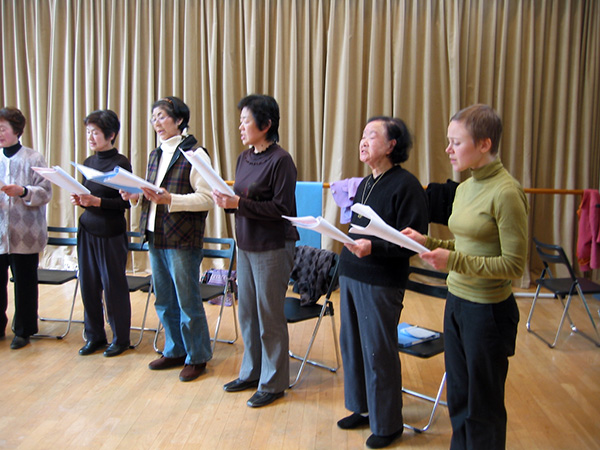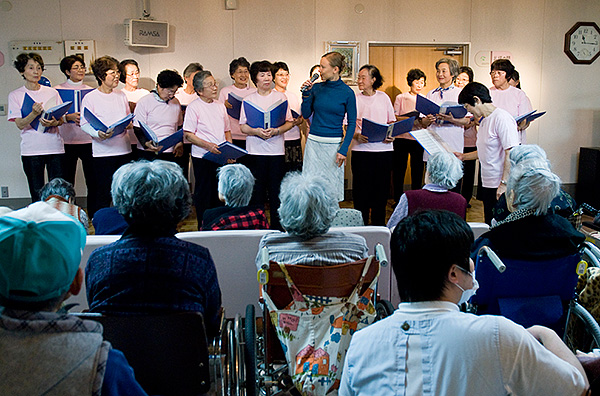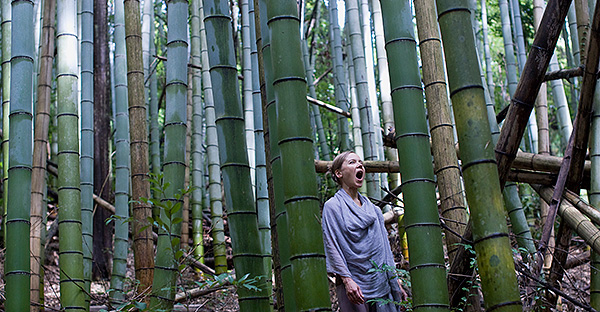

Heini Nukari(Performer)
In 2007 I was invited to participate in the trans_2006-2007 Residence Support Program at the Akiyoshidai International Art Village. It was my first time visiting Japan and I was thrilled to spend 70 days in a new place. In 2007 we were altogether three artists from different countries, each realising our own project. Since that first long residency, I have returned to AIAV as a fellow artist in 2008, 2010 and 2011. Due to all those residencies Japanese culture, nature and its people have become a precious and continuous source of inspiration for me.
I work with movement, voice and sound design. I also write songs, make choreographies and play instruments. I consider myself as an explorer of the possibilities of the body and its relation to the world, nature and people. Therefore, traveling to foreign countries and spending time in different cultures is a crucial part of my work. Even as I explore the possibilities of expression in the human body, I also explore geographic and cultural landscapes. I am interested in how the interaction between people and environment influences our creative ways of expression. I believe that experiencing and making art can add to the general well-being of the world.
Inspired by Japan
I have always felt drawn to Japan. Therefore I was highly motivated to apply for the long residency at the AIAV in 2007. That time I was also looking for new artistic impulses and dreaming of a situation in which I could fully concentrate only on one art project and share it with a community. Furthermore, I was yearning to get away from Europe and big city life for a while. In many ways the AIAV exceeded my expectations and became a very important part of my life for the next years.
It is always inspiring for me to be in Japan. It makes me extremely awake because I am continuously observing and learning. Japanese people are extremely considerate with each other. The intuitive respect and feeling for each other’s physical and mental space is something I admire and feel very comfortable with. The social behavior is like a fine choreography, serious and playful at the same time. People are highly sensual and know how to enjoy the small details of life. Also, the fact that the Japanese people seem even more shy than the Finnish makes the country all the more sympathetic in my eyes. While in Japan, it feels natural for me to adapt as much as possible to the ways of the Japanese.
During the years I have established invaluable friendships with people around AIAV and other areas and cities. Somebody once suggested that I could be named as the “grass-root level ambassador” between Europe and Japan. Maybe. In general I think that to develop an open and natural contact with each other, we people need to spend time together, be it sharing food or singing and playing together.
Continuous projects at AIAV
My first project at the AIAV was an artistic research about the similarities between Japanese language and my mother tongue Finnish. I had never studied Japanese before but had a feeling for the language. After arriving in AIAV I started private Japanese lessons with Ms. Rieko Tahara, a Japanese language teacher living nearby. Not only was she the perfect person to teach me the basics of Japanese but she also introduced me to the creative and playful side of the spoken Japanese, like the use of onomatopeic words. Despite the geographic distance and different grammatical structure, Japanese and Finnish share a very similar rhythm and a love for vowels and soft sounds. The two languages simply rhyme well together. Since I was especially interested in the use of words in singing and storytelling, I started to combine and mix Japanese and Finnish words in a playful way. I developed an intuitive and poetic language called Finippongo (a name given by Ms. Machiko Harada, the curator at AIAV in 2007). The idea of the new language was not necessarily to make much sense but rather to move between the meanings in an associative level.
Connected to the language research I was eager to learn about the rich Japanese folk culture, specially the stories, songs and dances about animals and their role in Shintoism. Since I was interested in folk songs, I was introduced to the IKI IKI Ladies, an elderly women’s choral group from the nearby village Shuho-Cho. The Ladies taught me several songs and invited me to sing with them at nursery homes and village festivals. Out of the verbal and physical material collected, I developed a singing performance called “Niko Niko Maa Maa“. The language Finippongo keeps developing further with every new visit to Japan.
 IKI IKI Ladies (2007)
IKI IKI Ladies (2007)
” width=”600″ height=”450″ />
Practicing with the IKI IKI Ladies (2007)
In 2008 I returned to AIAV to realise a visual-acoustic project “Naka e Miru Soto e Kiku” (“Insight Out Here To See“) in the frame of “trails_“, a program honoring the 10th Anniversery of the AIAV. The project was a collaboration with the photographer Joerg Fahlenkamp who had visited me at AIAV the previous year. In some ways we returned to continue the ideas which were born in 2007. We had been deeply touched and inspired by the lively fineness of the visual and acoustic atmospheres which we were experiencing when invited to visit private homes, specially the kitchens. We reconnected with the people whom we had met the year before and gently asked if we could visit them once more. Luckily, more often than not the invitations happened anyway, born out of real friendship with the families. Without breaking the natural situation during our visits, we documented the moments by using a large format camera and a sound recorder. We also found situations outside at public spaces which were fulfilled with the energy of the people who had been creating them. I composed soundtracks based on the field recordings made at the houses and spaces. Together the pictures and soundtracks were transmitting a strong sensory memory of the documented sceneries.
After being exhibited at the AIAV, the project was shown in a photo gallery in Berlin. Many European visitors were moved and surprised about what they saw and heard. It seemed that we were positively breaking the stereotypical picture of Japan as urban high-tech culture. What we were presenting, was the more hidden and private side of the Japanese life, very much alive and breathing in the rural areas.
In 2010 I was passing by Akiyoshidai on my travels in Japan and stopped over for a fortnight. During this residency I composed a song in Finippongo for the Iki Iki Ladies (called Iki Iki no Uta) and performed a solo performance influenced by my explorations with Japanese theatre and music culture. It was my shortest visit at AIAV but proved to be a meaningful preparation time for the upcoming visual-acoustic project originally inspired by my relationship with the Iki Iki Ladies.

Revisiting AIAV to present my latest performance KOOMORI and continue my researches in Japanese language (2010)
Iki Aito Sisko, a project realised in the Fall 2011 is a collaboration with my sister, photographer Aura Nukari. I already had lot of ideas for sound material but wanted to document the Ladies visually as well. My sister was a natural choice, also because of her special talent for portrait photography. Furthermore, I felt as if she was my visual counterpart who made me see the surroundings at AIAV in a fresh and more focused light. Thematically we focused on the Ladies but also on singing in general, sisterhood and communication between human beings and Japanese nature. The exhibition shows pictures and sounds of the Iki Iki Ladies and combines them with images which have born out of moments of us sisters sharing time together in the nature around AIAV. We have merged as one with the landscape and let the grass and trees tell us stories. This project is a tribute to the beauty of women of all ages and their relation to the surrounding nature. “Iki Aito Sisko” will be shown in Finland in March 2012.

Performing Susuki, a song written and composed for the chorale that I have been involved with over time (2011) ,Photos courtesy of AIAV
Communicating creatively with local people
One of the most substantial part of the residency periods have been the communication with the local people. The people around Akiyoshidai are relatively open. They are not necessarily overly curious but seem to accept and respect the presence of foreign artists around their fields. Personally I have noticed how much it helps when I can speak some Japanese, even if it is just about weather or about how tasty the sweet potatoes are this season. (The truth is that I am passionate about Japanese vegetables and pickles and enjoy talking about them.) Japanese on the other hand find it extremely interesting that a foreigner loves to eat Umeboshi, the famous pickled salty plums.
This communication is as valuable for the artists as it is for the local audience. Most of us residence artists normally live in big cities where we at times feel rather isolated from the so called normal life and people. Due to this isolation the making of art may become abstract and lacking in meaning. At least for me art is about dialogue between cultures and people. I am grateful that during the residency the artists are given the chance to take part in the local seasonal festivities and visit elementary schools, nursery homes or the university of Yamaguchi in order to connect with people from various stages of life. I can say that living and working at the AIAV has restored the meaningfulness of my own art making.

Recital at a senior residence, Photo courtesy of Aura Nukari
Even if the relatively isolated location of the AIAV makes it difficult for some people to visit our events, there is a faithful audience which keeps on taking part in the activities year by year. I remember when we had an open studio day in 2007. I invited the visitors to practice the title song of my performance “Niko Niko Maa Maa” with me. I was amazed and touched by how naturally and open-mindedly the people studied the somewhat funny Finippongo words with me and then sang the song with a natural ease. I have also taught short voice and movement workshops at the AIAV. The idea has been to let people experience physically what I do and to offer an introduction to a creative way to approach your own physicality and voice. Last year I even got some of the Iki Iki Ladies to join my workshop. It was beautiful to see people, young and old experiencing the joy of playful moving and singing.
Living in and around the AIAV
I appreciate how the staff of AIAV actively keeps on creating possibilities for the artists and people to meet and share time together. I am specially grateful for the wonderful curators without whom all my art projects would not have been possible. In 2007 and 2008 I was guided by Ms. Machiko Harada whose charisma and good relationship with the locals helped me to establish the trust and network for the coming projects. In 2010 and 2011 I was taken care by Ms. Junko Tsukada whose unrelenting support has made many things possible, specially in realising the Iki Aito Sisko exhibition. I admire how devoted these two women have worked and truly understood how to smoothen the ways for the various and often unconventional art projects taken place at AIAV.
The fact that the AIAV is far from citylife, makes it a perfect place to concentrate. The modern building complex hidden in the narrow valley and surrounded by the lush woods and soft mountains create an exciting working environment. In a way the architecture is somewhat utopistic and too big for the place but succeeds to sit well in the landscape. Last year my sister pointed out that viewed from outside, one of the buildings resembled a giant crab. We were pondering if this was only our perception or the architect had intended it, perhaps referring to the crabs living on the surrounding mountain slopes. Acoustically the outer arches and corridors of the main building offer exciting echoes. Every sound gets a clarity and a hall effect which seems to create a feeling of timelessness and space. I have always enjoyed the way it takes from the apartment building to the studio and around.

The AIAV facility is reminiscent of a crab, Photo courtesy of Aura Nukari
The AIAV is not only a place for us resident artists. Lot of local artists, specially musicians rehearse in the studios. Some nights the music studios are full of young musicians who let their heavy metal guitars echo through the night air. It’s a curious effect on the natural surroundings but mostly I could see it as a welcoming distraction to the otherwise so silent atmosphere.
The living conditions at the accommodation building are stylish but not the most comfortable which is to do with the highly designed but impractical furniture and poor cooking conditions. As I have been told, the original idea was that the artists would eat at the adjoining restaurant hall. Maybe this was working in the beginning but since the restaurant is not working on a daily basis, most of the artists cook their own meals at the common kitchen. Actually, cooking and eating is a activity enjoyed and practised by everybody and therefore the kitchen facilities should be much bigger and cozier. Maybe this will be the case one day.
But all in all there is something in the whole surroundings that makes me like it. It also feels nice to be surrounded by friendly caretakers, cleaning staff and gardeners who take care that everything is working. And above all, it is a luxury to have an own studio overlooking the forest. Since there are no distractions, one can fully concentrate on the creative process. Some artists might perceive the location as too isolated and the dark evenings too long. (And that is when you want to gather together in the kitchen!) It is very difficult to go out spontaneously even if Yamaguchi lies only half an hour away. On the other hand, the resident artist’s life is far from solitary. My time at AIAV has always been highly social as unexpected visitors and events take place almost daily. This trains a certain flexibility which I think is part of the life of an artist serving the community. Encounters with people feed my creativity and keep me believing that the role of an artist has a place in the society. I also think that the fact that I have lived in the rural Japan has brought me much closer to the Japanese culture in general than would have been the case had I stayed only in urban areas.
Surrounded by nature
I feel a strong connection with the Japanese nature. Behind the AIAV, there is a path leading up to the nearest mountain. On top of the mountain, accompanied by Tombi, the Japanese Eagle, one can enjoy a breathtaking view on the whole area. In 2007 I used to climb up the path almost every day. The way goes through an impressive old bamboo grove and from the beginning on this place has fascinated me. Every time I return to AIAV, the first thing I do is to go and greet the bamboos. The light and acoustics of the grove inspire me time and time again. During my last residency in 2011 I could share this fascination with my sister and we did a series of photographs and sound recordings among the bamboos.
It is incredibly important that artist residencies like the AIAV exist. The fact that I can fully concentrate on the project at hand and feel supported and integrated in the life in and around the AIAV is like a real “artistic healing time” for me. A time which stays with me afterwards as an example of how the life of an artist naturally should be. After every residency period I feel balanced and fulfilled. I try to keep this feeling alive and let it nourish and seep into my life outside the Akiyoshidai International Art Village.

In a bamboo grove, Photo courtesy of Aura Nukari
An Epilogue; A small Ode for Japan
When I get out of the airport in Osaka,
I fulfill my lungs with the soft and fragrant air.
A feeling of ease and comfort spreads into my body and mind.
I feel as if I’m arriving home.
When the airplane back to Europe is rolling into the runway,
I look outside the window and see three aircraft mechanics,
bowing and waving to our departing plane.
Silently I thank them and the whole Japan for taking care of me
once more and till the last moment. ARIGATOU!
Heini Nukari
Born in 1972 in Finland. Performer, vocalist and physical voice teacher. Holds BA in performing arts (School for New Dance Development, Amsterdam). Based in Berlin since 1997. Performing her own work, collaborating with other artists and teaching internationally. Participating in AIR programs in Japan and Germany.
www.whitedogballads.com
www.body-is-voice.com
—
Words of Recommendation
Junko Tsukada (Curator, Akiyoshidai International Art Village)
The Akiyoshidai International Art Village (AIAV) is located deep into the mountains. I am sure that the stately facilities, surrounded by nature and nothing else, surprise incoming artists picturing Japan as a mass pop culture producing country with colorful people and eccentric cityscapes.
At AIAV, we propose two residence programs: “Support”★1 and “Fellow”★2. While creation is not required from participants in the Fellow program, at the end of the Support program, artists present the results of their sojourn through exhibitions or stage performances. Although 70 days are hardly enough to produce a work of art, this objective of presenting their work is helping artists placed in this peculiar environment to schedule their sojourn accordingly and focus their research. However, the main purpose of the program is not to present or produce works of art.
Heini Nukari was selected through the open program and first came to Japan in 2007. As a performer with a musical education background, she started learning children songs from the local chorale, the IKI IKI Ladies, and ended singing songs in Japanese with them.
Many applicants to the program tend to appeal to the selection committee saying they want to “research the region and create something site-specific”. The methods of research vary greatly, but a lot is based on impressions or information gathered from resources or collaborators. However, Ms. Nukari was very different. She tried to immerse herself completely in this foreign culture, to sing in a foreign language and to become a member of this chorale. She didn’t approach the cultural life of our region as an object of study, but rather absorbed it. 5 years have passed since her first sojourn, yet she continues exchanging with the chorale and developing new works.
To complete a site-specific work of art in an unknown place and within a limited amount of time is definitely one way to sublimate research into art, but it seems to me that absorbing a foreign culture over a limited period of time like Ms Nukari did is the greatest privilege of artists able to stay in residence abroad. Over time, artists will digest their unique experiences and it would be our satisfaction if that experience gave them to new ideas or hints for their artistic careers.
The residence programs at AIAV are meant to provide a place for artist to experiment, not to pursue results over such a limited period. We consider our programs and the experiences here as stepping stones to long-term commitments that require perseverance on our part as well.
★1──The “Support Program” is open to artists under the age of 40, regardless of nationalities or genre. Each year, 3 selected artists are invited to create for 70 days, between January and March.
★2──The “Fellow Program” allow artists to do research. Artists have to be recommended by the selection committee or administrative, educational or international partners; or subsidized. It is possible for former artists in residence to come back and/or extend their research over the years. Residence period is 1 month maximum.
[March 31, 2012]
Reference:
AIR_J>SEARCH>Akiyoshidai International Art Village
AIR_J>RESOURCE>Book>trails_komichi:Little stories about Artist in Residence Program, AIAV
2024.7.9Acasă la Hundorf Residency JournalArtist : Miyake Suzuko
2023.5.14AIR and I, 09 : Mentoring Artists for Women’s Art (MAWA) Residence Report